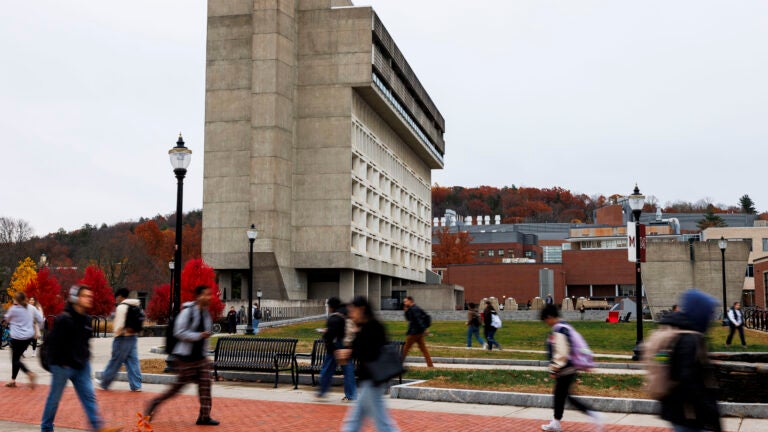Education
The report found notable disparities in median earnings across institutions, fields of study, and certain demographics.

A new report from the Massachusetts Department of Higher Education has shed light on the earnings of graduates from the state’s 29 public colleges and universities.
Working with the Commonwealth’s Performance Measurement Reporting System, the report focused on two specific metrics: the earnings of graduates who enrolled immediately after high school and the earnings of those who enrolled at age 25 or older. By examining these metrics, the report revealed how post-graduate earnings range across fields, institutions, and demographics.
According to the report, a graduate with an associate’s degree from a state public college earns approximately $20,000 more per year than a high school graduate five years after completing their postsecondary education. Holders of a bachelor’s degree, on the other hand, earn approximately $30,000 more per year after the same amount of time.
“The data is clear — Massachusetts degrees deliver,” Governor Maura Healey said in a statement. “When students graduate from our community colleges and public colleges, they get paid more, they have more opportunities for upward mobility, and they provide a skilled workforce for our employers.”
However, the exact earnings, which are sourced from data between 2014 and 2018, appear to vary by institution and field of study. The report indicates a wide range of earnings between the state’s public colleges, with a $20,000 gap alone between the 15 community colleges.
Massachusetts Maritime Academy came out on top with the highest median earnings, with alumni making an average of $98,418 per year five years after graduation, the report showed. This is more than $15,000 higher than the next highest-earning institution, and the gap is continuing to grow.
Graduates with bachelor’s degrees from UMass campuses also earned higher, according to the report. A full list of earning data obtained by The Boston Globe showed that the next three colleges with the highest median earnings were UMass Lowell with $81,050 per year, UMass Amherst with $80,441 per year, and UMass Boston with $74,042 per year.
Across the board, median earnings from community college graduates were lower, with 10 out of the 15 statewide schools placing in the bottom half of the overall data. Bunker Hill Community College and Berkshire Community College were the only ones with median earnings of more than $70,000, the Globe reported.
The report indicated, however, that the gap in earnings between institutions may be partially influenced by the programs and subsequent occupational fields that graduates pursue. While Mass Maritime had the highest earners by far, it also has significantly more graduates pursuing STEM careers, which are typically higher-paid, than any of the other colleges.
High earnings were also associated with graduates who earned degrees in health sciences and the trades, according to the report. In some cases, graduates with a certain associate’s degree earned higher than another graduate with a bachelor’s degree in a different field of study, such as arts and humanities, human services, and education.
For instance, data from the report indicated that health graduates with an associate’s degree from a community college had median earnings of $76,480, while arts and humanities graduates with bachelor’s degrees from state universities and UMass campuses had median earnings of $59,417.
Despite this gap, the report noted that these fields of study have shown differing earning trajectories over time. STEM subjects, for example, “have an earnings premium in the early years post completion, but this effect often is reduced over time, and the earnings gap shrinks,” according to the report.
Though the gaps in median earnings between institutions and fields of study were indicated to be increasing, the differences between socioeconomic and racial groups have decreased, the report showed. Whereas the gap between high-income and low-income high school graduates was 35 percent, the same gap for graduates with associate’s and bachelor’s degrees was down to 12 percent and 8 percent, respectively.
Along similar lines, a 25 percent gap between racial demographics of high school graduates was reduced to 13 percent and 17 percent for graduates with an associate’s degree and a bachelor’s degree, respectively. In all cases, Asian American and Pacific Islander graduates had the highest median incomes.
However, the study found notable earning disparities by gender, with female bachelor’s degree recipients earning 10 to 20 percent less than their male counterparts, particularly in STEM fields. Five years after graduation, this translates to a gap of $13,560 for associate’s degree holders and $17,368 for bachelor’s degree holders.
Though there are still earnings discrepancies between different career paths, colleges, and fields of study, the findings indicate that the earnings premium is high compared to high school graduates.
“As a proud public college graduate, this report shows what I have long known — public higher education in Massachusetts is key to lifelong career success,” Lieutenant Governor Kim Driscoll said in a statement. “Importantly, our public higher education graduates are more likely to stay in Massachusetts where they will continue their contributions to our economy and our communities.”
Sign up for the Today newsletter
Get everything you need to know to start your day, delivered right to your inbox every morning.



